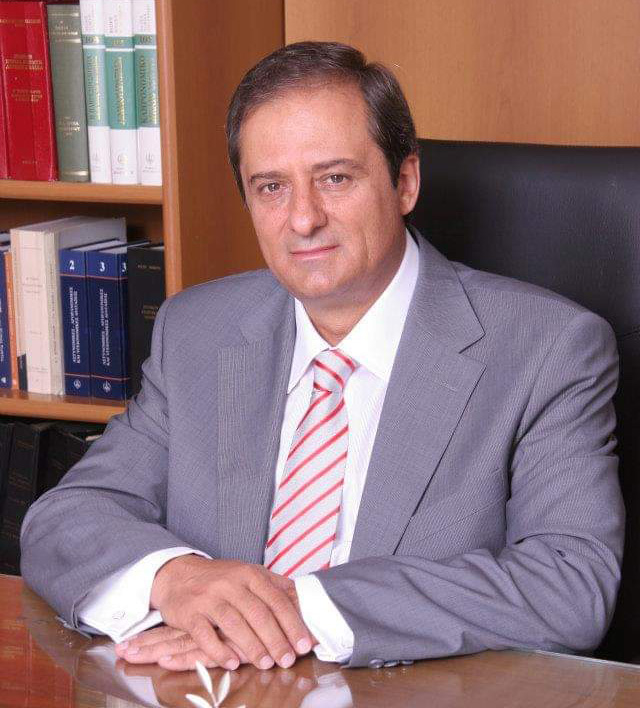Ο Πρόεδρος
Πρόεδρος του ΦΟΔΣΑ Πελοποννήσου είναι ο κ. Γιάννης Σμυρνιώτης

Πρόεδρος του ΦΟΔΣΑ Πελοποννήσου είναι ο κ. Γιάννης Σμυρνιώτης

President of FODSA Peloponnese is mr Stayros Argeitakos, Municipal board member and former Mayor of the Minicipality of Sparta.


Τι είναι ο ΦΟΔΣΑ
Ο Περιφερειακός Σύνδεσμος Φορέων Διαχείρισης Στερεών Αποβλήτων (ΦΟΔΣΑ) Περιφέρειας Πελοποννήσου συστάθηκε με την 2555/28-05-2012 (ΦΕΚ 1810Β’/08-06-2012) Απόφαση του Γενικού Γραμματέα Αποκεντρωμένης Διοίκησης Πελοποννήσου, Δυτικής Ελλάδας και Ιονίου δυνάμει των άρθρων 13 και 17 του Ν.4071/2012.
Λειτουργεί από το 2014 μετά την 45556/4607/02-10-2013 (ΦΕΚ 2565Β’/11-10-2013) απόφαση του Γενικού Γραμματέα Αποκεντρωμένης Διοίκησης Πελοποννήσου, Δυτικής Ελλάδας και Ιονίου περί συγχώνευσης των επτά (7) φορέων Διαχείρισης Στερεών Αποβλήτων που λειτουργούσαν στην Περιφέρεια Πελοποννήσου στον Περιφερειακό Σύνδεσμο Φορέων Διαχείρισης Στερεών Αποβλήτων (ΦΟΔΣΑ) Περιφέρειας Πελοποννήσου ως Νομικό Πρόσωπο Δημοσίου Δικαίου των Ο.Τ.Α. της Περιφέρειας Πελοποννήσου.
Διοικείται από 53μελές Διοικητικό Συμβούλιο στο οποίο συμμετέχουν αιρετοί αντιπρόσωποι όλων των Δήμων της Περιφέρειας Πελοποννήσου σύμφωνα με το άρθρο 246 του Ν.3463/2006 (Κύρωση Κώδικα Δήμων και Κοινοτήτων) το οποίο εκλέγει τον Πρόεδρο του Φορέα καθώς και 7μελή Εκτελεστική Επιτροπή.
Σκοπός του ΦΟΔΣΑ
Σκοπός του Περιφερειακού Συνδέσμου ΦΟΔΣΑ Περιφέρειας Πελοποννήσου είναι η ολοκληρωμένη διαχείριση των στερεών αποβλήτων, σύμφωνα με το Περιφερειακό Σχέδιο Διαχείρισης Αποβλήτων (ΠΕΣΔΑ), και ειδικότερα η εξειδίκευση και υλοποίηση των στόχων και των δράσεων αυτού για την προσωρινή αποθήκευση, μεταφόρτωση, θαλάσσια μεταφορά ΑΣΑ, επεξεργασία, ανάκτηση και διάθεση των στερεών αποβλήτων της χωρικής του αρμοδιότητας σύμφωνα με την κοινή υπουργική απόφαση 257/2009 (Α’83).
Συγκεκριμένα, η αρμοδιότητα του σχεδιασμού των έργων διαχείρισης στερεών αποβλήτων αφορά την εκπόνηση και παρακολούθηση υλοποίησης του Περιφερειακού Σχεδιασμού Διαχείρισης Στερεών Αποβλήτων (ΠΕΣΔΑ) της Περιφέρειας Πελοποννήσου, ενώ η αρμοδιότητα διαχείρισης των στερεών αποβλήτων αφορά την προσωρινή αποθήκευση, μεταφόρτωση, επεξεργασία, αξιοποίηση και διάθεση των στερεών αποβλήτων της περιοχής ευθύνης του.

What is the FODSA?
The Regional Association of Solid Waste Management Entities (FODSA) of the Peloponnese Region was established by the 2555/28-05-2012 (Government Gazette 1810B΄/08-06-2012) Decision of the Secretary General of the Decentralized Administration of Peloponnese, Western Greece, and Ionian Islands under Articles 13 and 17 of Law 4071/2012.
It has operated since 2014 pursuant to the 45556/4607/02-10-2013 (Government Gazette 2565Β΄/11-10-2013) decision of the Secretary General of the Decentralized Administrative of the Peloponnese, Western Greece, and Ionia Islands regarding merging of the seven (7) solid waste management entities in the Peloponnese Region to form the Regional Association of Solid Waste Management Agencies (FODSA) of the Peloponnese Region aw a Public Law Legal Entity of the Peloponnese Region.
It is governed by a 53-meber Board of Directors which is composed of representatives of all municipalities of the Peloponnese Region according to Article 246 of N. 3463/2006 (Code of Municipalities and Communities) which elects the Entity and 7-member Executive Committee.
Purpose of the FODSA
The purpose of the Regional Association of the Peloponnese Region is integrated management of solid waste, in accordance with the Regional Wase Management Plan (Waste Management Plan)? inparticular, to identify and implement the objectives and actions for temporary storage, transshipment, sea transport of MSW, processing, recovery and disposal of solid waste of the territorial jurisdiction in accordance with the joint Ministerial Decision 257/2009 (A΄83).
Specifically, planning the solid waste management projects preparation and monitoring of the implementation of the Regional Solid Waste Management Plan (PESDA) of the Peloponnese Region, while solid waste management concerns temporary storage, transshipment, treatment, recovery, and disposal of solid waste in the allocated region.
It's easy to get started creating your website. Knowing some of the basics will help.
A content management system is software that allows you to create and manage webpages easily by separating the creation of your content from the mechanics required to present it on the web.
In this site, the content is stored in a database. The look and feel are created by a template. Joomla! brings together the template and your content to create web pages.
To login to your site use the user name and password that were created as part of the installation process. Once logged-in you will be able to create and edit articles and modify some settings.
Once you are logged-in, a new menu will be visible. To create a new article, click on the "Submit Article" link on that menu.
The new article interface gives you a lot of options, but all you need to do is add a title and put something in the content area. To make it easy to find, set the state to published.
The look and feel of your site is controlled by a template. You can change the site name, background colour, highlights colour and more by editing the template settings. Click the "Template Settings" in the user menu.
The boxes around the main content of the site are called modules. You can modify modules on the current page by moving your cursor to the module and clicking the edit link. Always be sure to save and close any module you edit.
You can change some site settings such as the site name and description by clicking on the "Site Settings" link.
More advanced options for templates, site settings, modules, and more are available in the site administrator.
Your site actually has two separate sites. The site (also called the front end) is what visitors to your site will see. The administrator (also called the back end) is only used by people managing your site. You can access the administrator by clicking the "Site Administrator" link on the "User Menu" menu (visible once you login) or by adding /administrator to the end of your domain name. The same user name and password are used for both sites.
There is much more to learn about how to use Joomla! to create the website you envision. You can learn much more at the Joomla! documentation site and on the Joomla! forums.


